Overview
The article provides a comprehensive step-by-step guide on how to effectively use the Contour Blood Glucose Meter, emphasizing the importance of preparation and proper technique for accurate readings. It supports this guidance by detailing essential pre-testing steps, troubleshooting common issues, and explaining how to interpret blood glucose results, thereby ensuring users can manage their diabetes effectively.
Introduction
In the realm of diabetes management, the right tools can make all the difference. The Contour Blood Glucose Meter emerges as a leading device, renowned for its user-friendly design and impressive accuracy. With features like the ColorSure Dynamic Range Indicator, this meter not only empowers users to track their glucose levels effectively but also enhances their overall management of diabetes.
As individuals navigate their health journeys, understanding how to utilize such devices—alongside supportive resources like T2DSolutions—becomes crucial. This article delves into the essential features of the Contour meter, preparation steps for accurate testing, troubleshooting common issues, and the interpretation of glucose readings, all aimed at fostering better health outcomes for those living with diabetes.
Understanding the Contour Blood Glucose Meter: Key Features and Benefits
The contour blood glucose meter is distinguished by its user-centric design and high accuracy, making it an essential tool for effective blood sugar control. Supported by LifeScan Global Corporation, research has demonstrated that 91% of subjects found the ColorSure Dynamic Range Indicator effective in determining whether their results were in or out of range, lending credibility to the device's features. Joyce Lee, M.D., M.P.H., emphasizes the importance of such tools, stating, 'The integration of user-friendly features in blood sugar meters is crucial for empowering patients in their diabetes management.'
With the ability to store up to 480 readings, users can easily monitor their sugar levels over time. The device includes a large display that improves readability and a smart light indicator that offers instant feedback, allowing rapid evaluations of sugar levels. Furthermore, a case study on convergent validity highlighted significant correlations between CGM-SAT scores and the frequency of CGM use, illustrating the relationship between effective glucose monitoring and improved management outcomes.
The accuracy of the contour blood glucose meter, along with its compatibility with Contour's mobile app, enables effortless trend tracking, which is essential for effectively managing blood sugar levels. Recently, T2DSolutions has emerged as a valuable resource hub for Type 2 and Type 3 diabetes education and community support, offering tools and information that complement the use of such monitoring devices. By understanding and utilizing the features of the contour blood glucose meter along with the educational resources provided by Td Solutions, you can maximize the meter's potential, leading to more efficient and effective glucose monitoring.
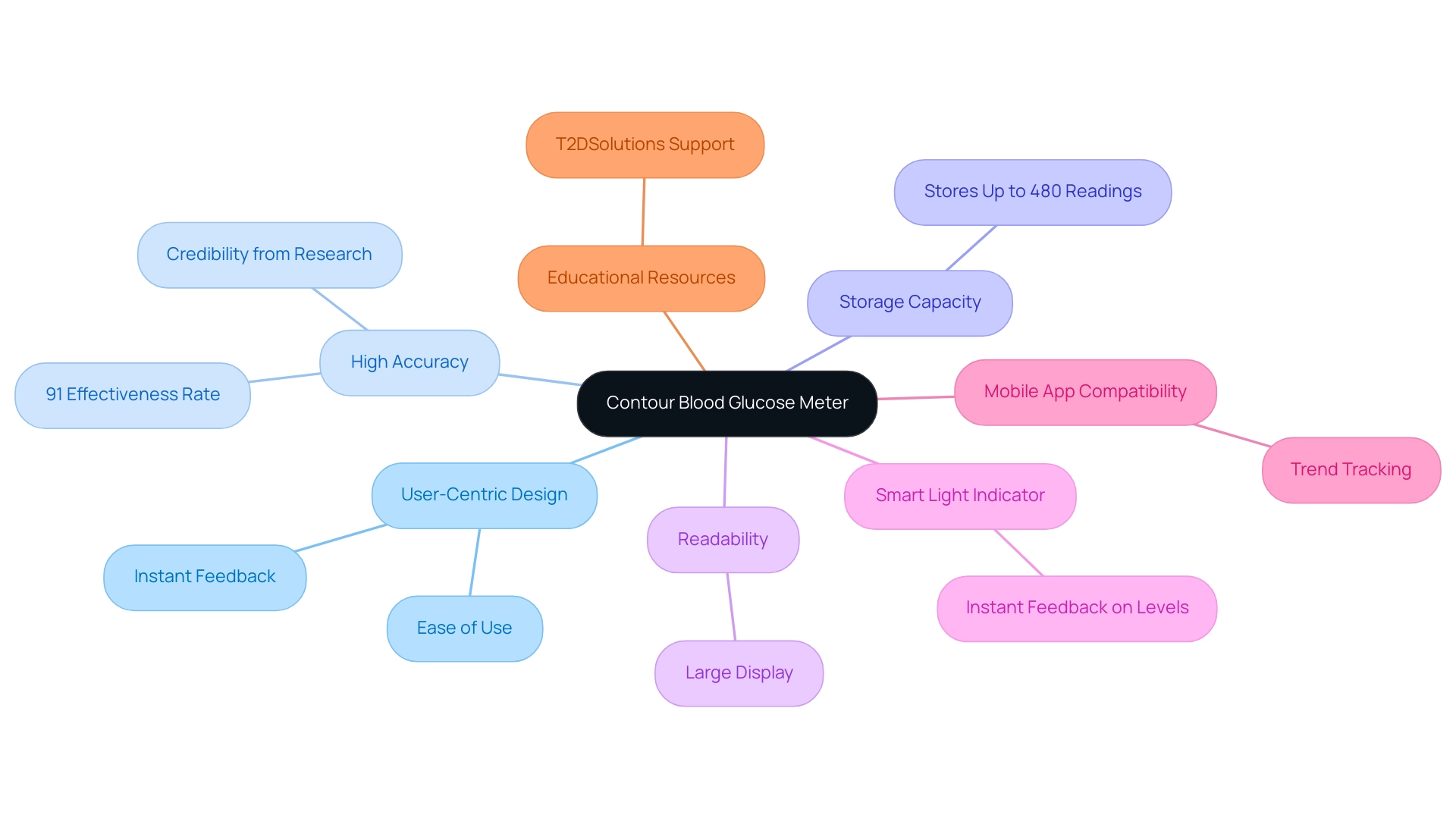
Preparing for Use: Essential Steps Before Testing
To ensure accurate readings with the contour blood glucose meter, it's crucial to follow these essential preparation steps:
-
Wash your hands thoroughly with soap and warm water to eliminate any potential contaminants, and dry them completely. This simple act is vital, as Angela M. Bell, MD, FACP, emphasizes,
After learning you have prediabetes, you may work with your healthcare team to make changes to your eating style, weight management, and physical activity.
-
Collect your supplies: This should include the blood sugar meter, test strips, lancing device, and alcohol wipes.
-
Check the expiration date on your test strips to confirm their validity, as expired strips can lead to inaccurate results.
-
Set up a comfortable testing area with good lighting to ensure ease of use.
It's crucial to observe that a fasting blood sugar test result of 126 mg/dL or higher may suggest a condition, emphasizing the importance of precise measurements. Thorough preparation involves not just possessing the appropriate tools but also recognizing that dependable measurements from a contour blood glucose meter can greatly influence your condition control and assist in avoiding issues related to blood glucose variations.
As T2D Solutions launches as your comprehensive resource for Type 2 and Type 3 diabetes education and community support, remember that a multidisciplinary approach involving various healthcare professionals is essential for effective diabetes care.
This is demonstrated in the case study titled 'Community and Rehabilitation Setting-based Care,' which highlights the significance of education on diet, exercise, and medication oversight. By adopting these best practices and utilizing the resources available at T2 Solutions, you can enhance the precision of your testing and make informed decisions regarding your health. Td Solutions provides a range of educational resources, community assistance, and expert perspectives to empower you on your health management journey.
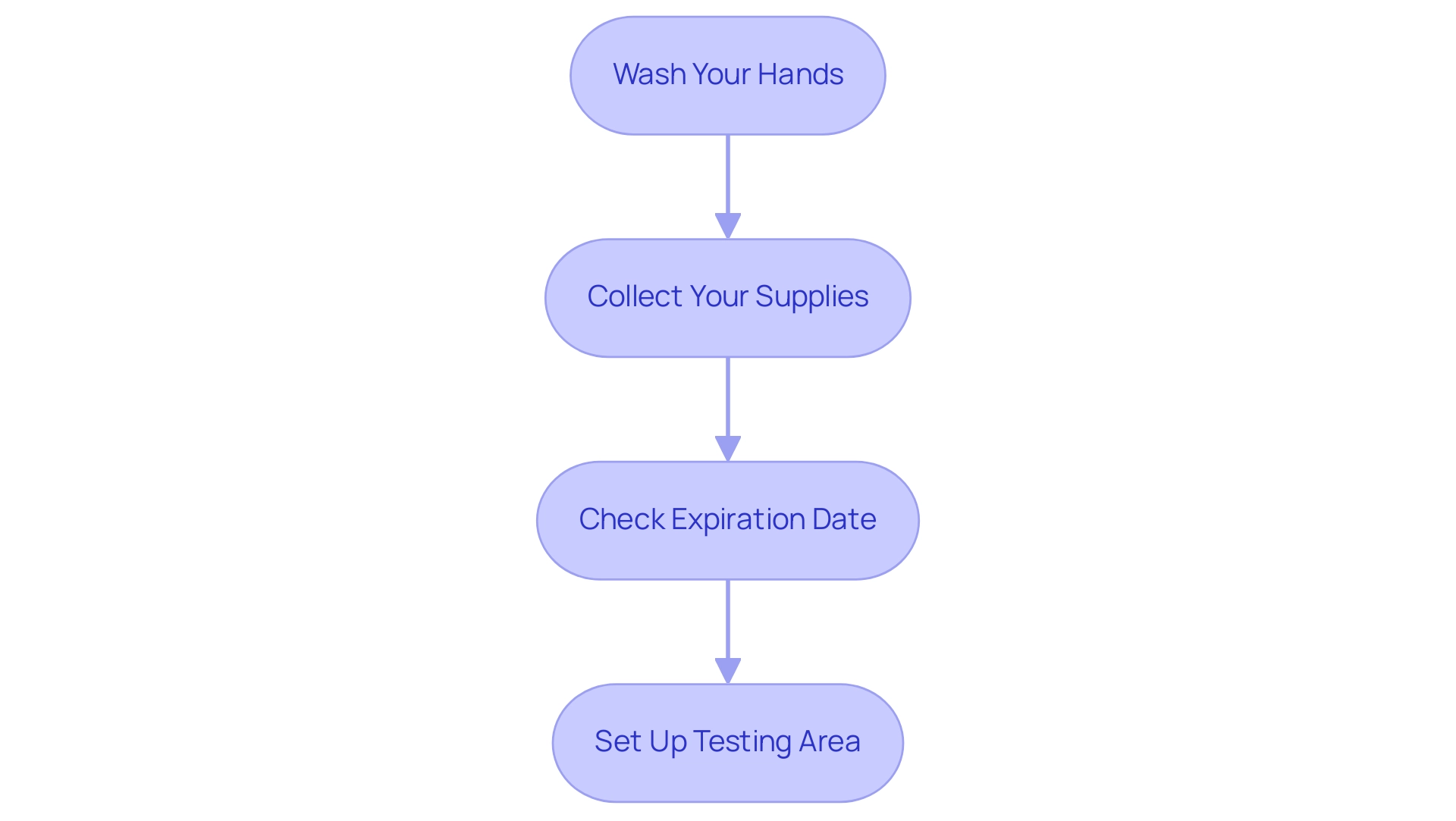
Step-by-Step Instructions for Using the Contour Meter
Utilizing the contour blood glucose meter efficiently requires a number of simple steps aimed at guaranteeing precise measurements, which are crucial for managing your condition. Follow this guide:
- Insert a test strip into the meter; this action will automatically power it on.
- Prepare the lancing device by inserting a new lancet and adjusting the depth setting to suit your comfort level.
- Prick the side of your fingertip with the lancing device to obtain a small drop of blood.
- Touch the drop of blood to the edge of the test strip; the meter will emit a beep once it has collected enough blood for testing.
- Wait for the result to display, which typically appears within a few seconds.
- Record your results in a logbook or a tracking app to monitor your levels over time.
This organized method not only enables precise testing of blood sugar using a contour blood glucose meter but also aids in efficient condition oversight. T2DSolutions is committed to being a valuable resource for newly diagnosed patients by providing educational materials and community support tailored to your needs.
As Mathew TK emphasizes, 'Implementing a systematic process to manage modified blood sugar levels requires input and active collaboration with the client as a consumer, endocrinologists, nurse educators specializing in endocrine health, pharmacists, clinical nurse specialists, dieticians, and data analysts.' For instance, P.Q.'s bedtime blood sugar level is 131 mg/dl, with a standard deviation of 120.65 mg/dl, highlighting the variability in sugar control.
Furthermore, the Continuous Glucose-EGA (CG-EGA) case study illustrates advancements in technology that enhance the accuracy of glucose monitoring, which is crucial for effective management of the condition. As you navigate your diabetes journey, remember that Td Solutions is here to provide education and community support tailored to your needs, including access to forums where you can connect with others and share your experiences.
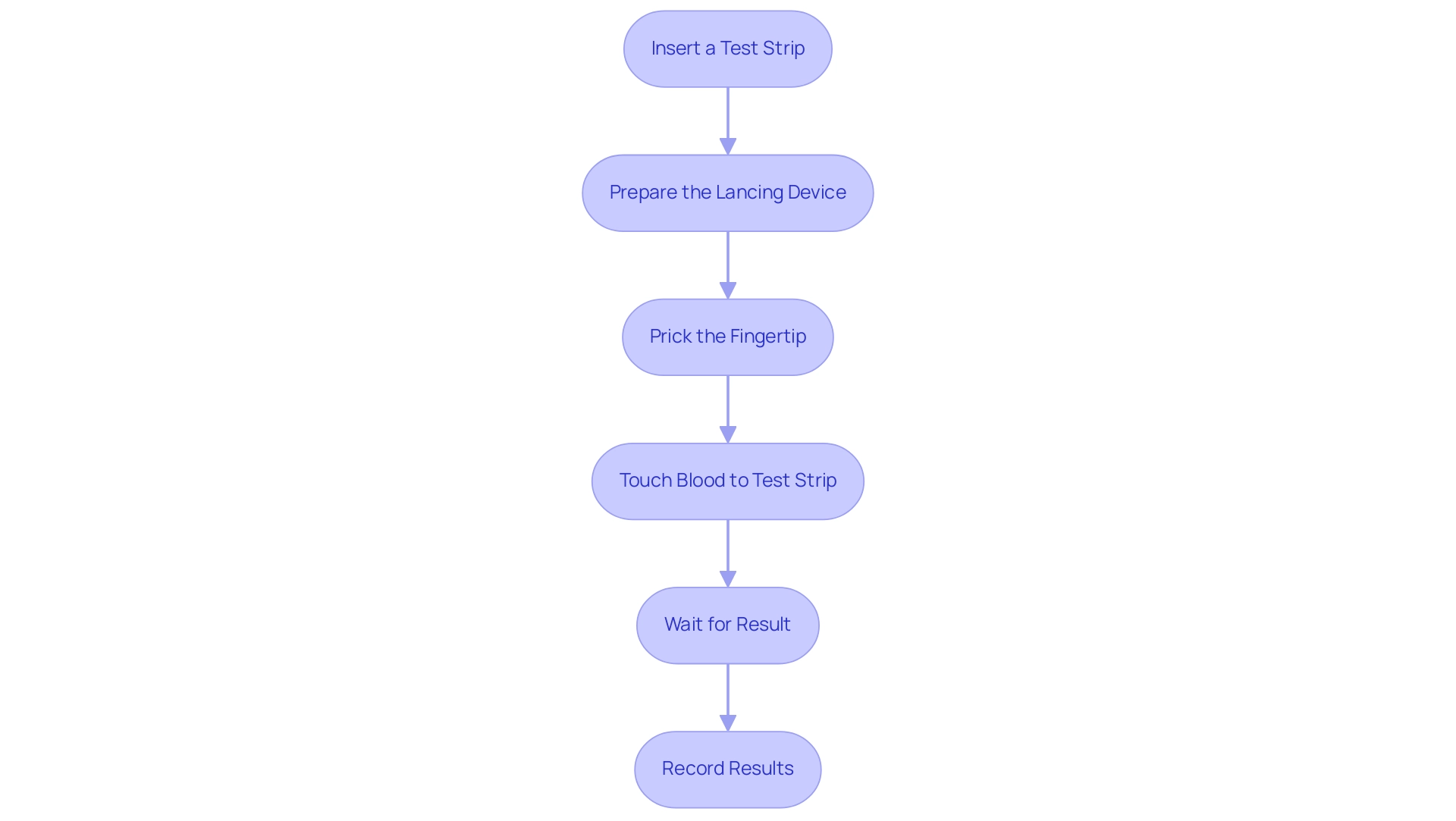
Troubleshooting Common Issues with the Contour Meter
The contour blood glucose meter, although user-friendly, can present a few common issues that users should be aware of:
-
Error Messages: Encountering error messages can be frustrating. It's important to verify that the test strip is inserted correctly and has not expired.
If error messages persist, it may indicate a deeper issue with the contour blood glucose meter or the accompanying test strips.
-
Inconsistent measurements can lead to significant health risks.
Research indicates that only 14.6% of children permitted their hands to dry before measuring glucose, which can lead to inaccurately low values. This statistic underscores the importance of proper testing protocols; not allowing hands to dry can compromise the accuracy of results, potentially leading to dangerous health decisions. Always ensure your hands are clean and dry before using the contour blood glucose meter and use fresh test strips.
-
Device Not Turning On: If your meter fails to power up, it’s likely due to depleted batteries. Replacing the batteries should restore functionality.
For ongoing issues with the contour blood glucose meter, consulting the user manual is advisable, and do not hesitate to reach out to customer support for guidance.
Additionally, as highlighted by Parkes and associates, a team of experts in managing blood sugar conditions, utilizing a structured approach to troubleshooting can help avoid errors: 'the Parkes grid avoids this by having an intervening 'B' zone between the 'A' and any higher zone.' This methodology can assist in interpreting results and managing meter performance effectively. A case study involving a 24-year-old woman with type 1 diabetes illustrates the potential consequences of erroneous measurements.
Initially misdiagnosed due to a point-of-care measurement that suggested manageable hyperglycemia, further testing revealed a critical diabetic ketoacidosis (DKA) condition. This incident highlights the necessity for meticulous testing protocols and adherence to sound performance standards for SMBG monitors to ensure precise measurements and timely interventions.
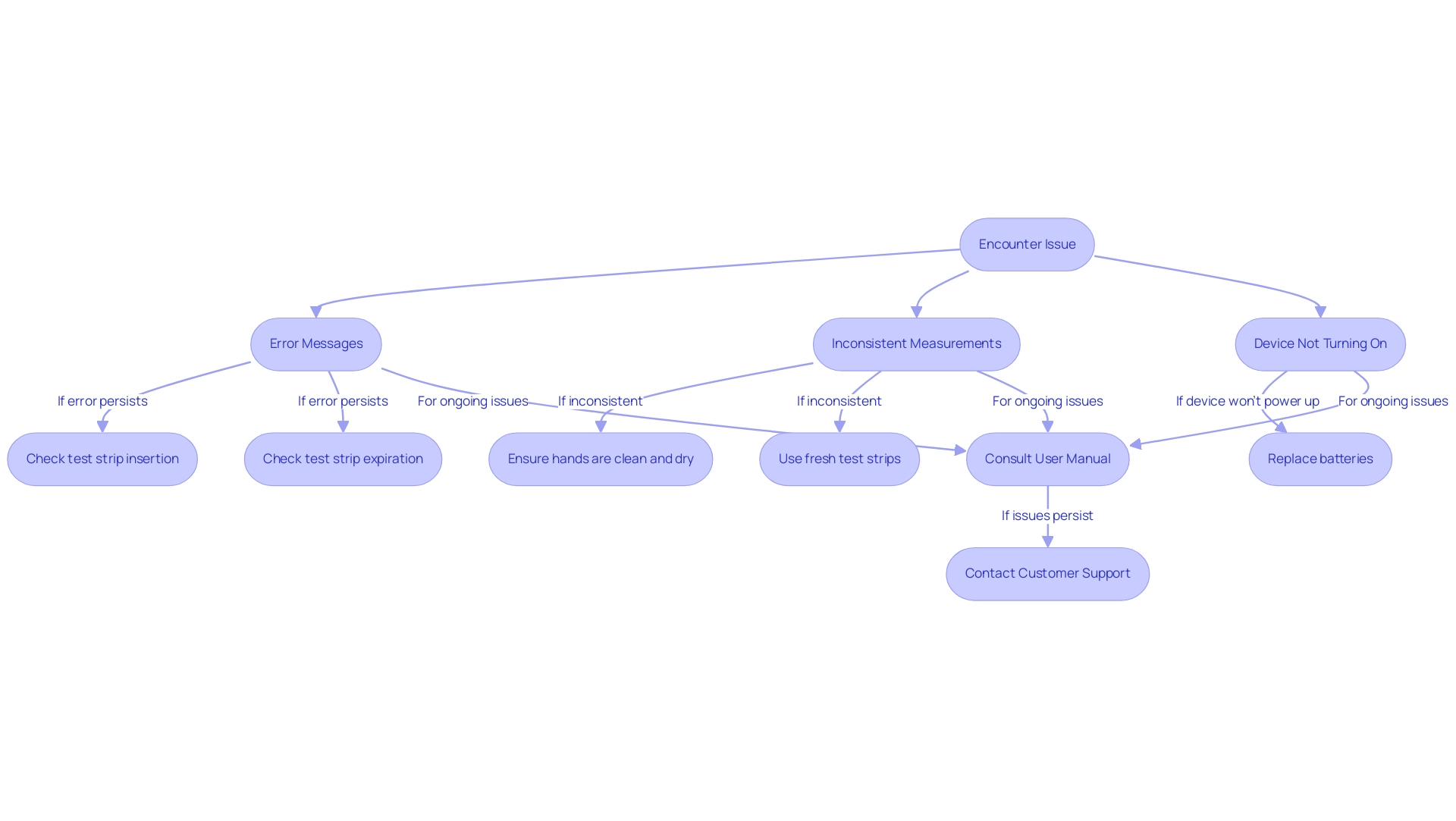
Interpreting Your Results: Understanding Blood Glucose Readings
Blood sugar levels can vary due to several factors, including the time of day and food intake. For most adults managing diabetes, a reading between 70-130 mg/dL before meals is typically deemed normal, while post-meal readings should ideally remain below 180 mg/dL. It is important to note that hypoglycemia occurs when sugar levels drop below 70 mg/dL, which can pose serious health risks.
Elevated glucose levels may signal the necessity for dietary modifications, adjustments in medication, or changes in physical activity. Engaging in discussions with your healthcare provider about your readings is crucial. As highlighted in the case study 'What to Expect from Your Doctor,' healthcare providers will ask detailed questions about symptoms, family history, diet, and exercise habits, which aids in accurately diagnosing and managing the condition.
Moreover, continuous blood sugar monitors (CGMs) offer real-time data and can notify users of hazardous levels, rendering them essential instruments for effective health control. As Dr. Meredith Goodwin, MD, FAAFP, emphasizes,
Speak with a healthcare professional to best determine your sugar targets.
This collaborative approach guarantees that your oversight strategy is customized to your distinct situation, promoting effective control of blood sugar.
T2DSolutions is committed to supporting newly diagnosed patients by offering a range of resources, including educational articles, community forums for shared experiences, and tools for tracking glucose levels. To stay updated on the latest resources and community insights, consider subscribing to our newsletter. Together, we can navigate the journey of diabetes management.
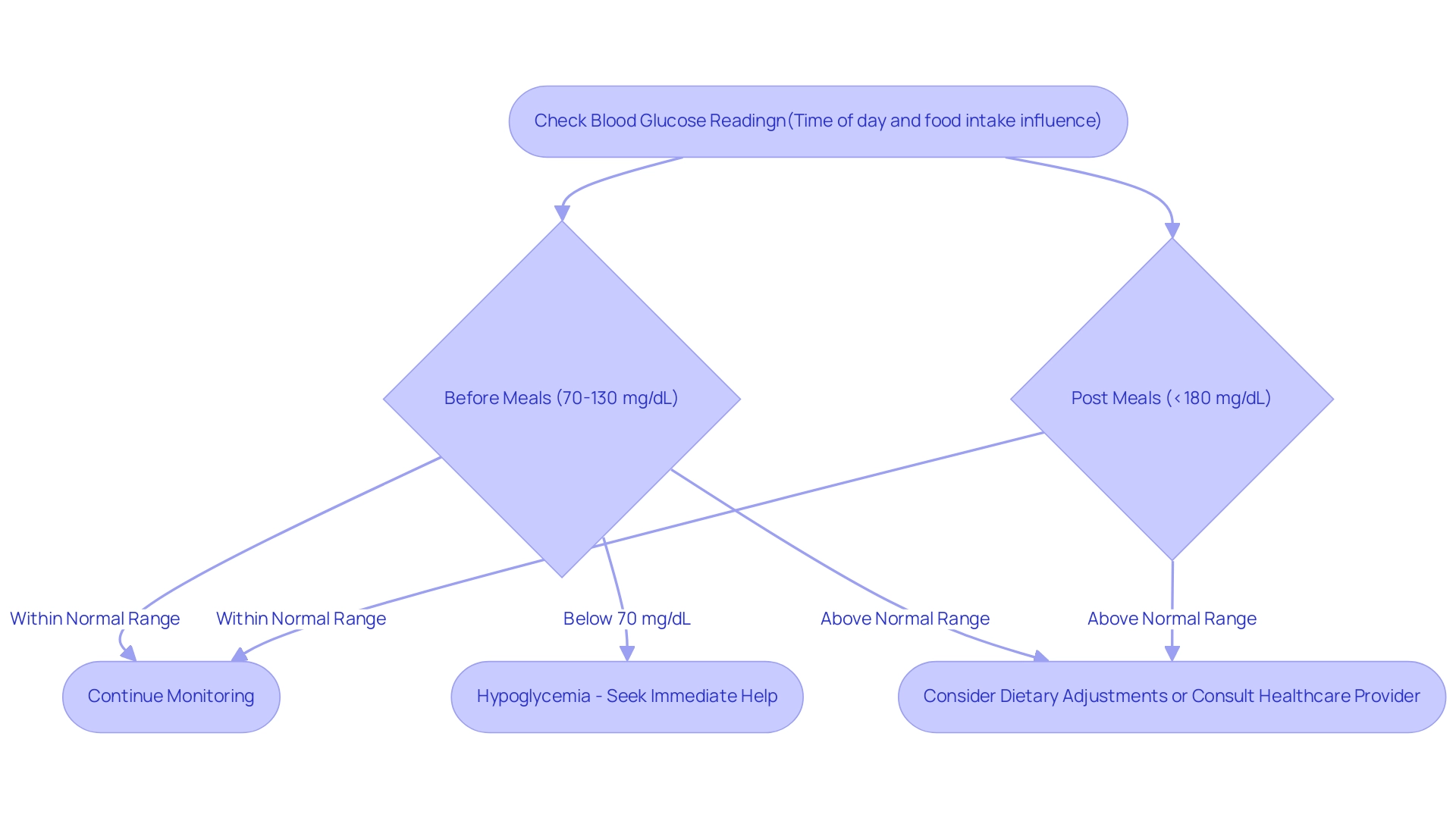
Conclusion
The Contour Blood Glucose Meter is a pivotal tool in diabetes management, combining user-friendly design with precision to empower individuals in tracking their glucose levels effectively. Its standout features, such as the ColorSure Dynamic Range Indicator and the capacity to store numerous readings, enable users to monitor their health with confidence. Preparation steps, including proper handwashing and using valid test strips, are essential for ensuring accurate results, which are foundational for informed diabetes management.
Understanding how to use the Contour meter correctly, along with troubleshooting common issues, can significantly enhance the user experience and reliability of readings. Clear instructions and the ability to interpret blood glucose levels provide users with the insight needed to make timely health decisions. As highlighted throughout the article, utilizing resources like T2DSolutions can further support individuals on their journey, offering educational materials and community connections that reinforce the importance of a multidisciplinary approach to diabetes care.
Ultimately, the integration of advanced technology with accessible resources fosters a proactive approach to diabetes management. By leveraging the capabilities of the Contour Blood Glucose Meter and engaging with supportive communities, individuals can take charge of their health, leading to improved outcomes and a more empowered lifestyle. Embracing these tools and knowledge is crucial for navigating the complexities of diabetes, ensuring that effective management becomes not just a goal, but a reality.
Frequently Asked Questions
What makes the contour blood glucose meter an essential tool for blood sugar control?
The contour blood glucose meter is known for its user-centric design and high accuracy, making it crucial for effective blood sugar management.
How effective is the ColorSure Dynamic Range Indicator in the contour blood glucose meter?
Research has shown that 91% of subjects found the ColorSure Dynamic Range Indicator effective for determining whether their results were in or out of range.
What features contribute to the user-friendliness of the contour blood glucose meter?
The meter features a large display for improved readability, a smart light indicator for instant feedback, and the ability to store up to 480 readings for easy monitoring over time.
How does the contour blood glucose meter support trend tracking?
The meter's accuracy and compatibility with Contour's mobile app enable users to effortlessly track trends in their blood sugar levels.
What preparation steps are essential for accurate readings with the contour blood glucose meter?
Essential preparation steps include washing hands thoroughly, collecting necessary supplies (meter, test strips, lancing device, alcohol wipes), checking the expiration date on test strips, and setting up a comfortable testing area with good lighting.
Why is it important to have accurate measurements with the contour blood glucose meter?
Accurate measurements are vital as a fasting blood sugar test result of 126 mg/dL or higher may indicate a health condition, making precise readings critical for effective condition control.
What resources does T2D Solutions provide for diabetes education and support?
T2D Solutions offers a comprehensive resource hub for Type 2 and Type 3 diabetes education and community support, including educational resources and expert perspectives to assist in health management.
How does a multidisciplinary approach benefit diabetes care?
A multidisciplinary approach involving various healthcare professionals is essential for effective diabetes care, as demonstrated in case studies focusing on education regarding diet, exercise, and medication oversight.
